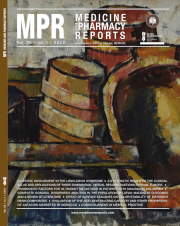Effect of micro osteo-perforations (MOP) on the rate of tooth movement and levels of interleukin-1β - a split mouth study
DOI:
https://doi.org/10.15386/mpr-1911Keywords:
micro osteo-perforations, MOP, tooth movement, rapid tooth movement, interleukin-1βAbstract
Introduction. Various procedures are available today to enhance tooth movement, with relative success rates, one among them being Micro Osteo Perforation (MOP). Our aim is to assess the rate of tooth movement and interleukin 1β levels in gingival crevicular fluid levels (GCF)after MOPs.
Methodology. A group of 22 patients were selected, who required first premolars extraction and were designated for the split mouth study with equal allocation. MOP was performed on the right side, three vertical MOPs were given using 1.2 X 8 mm mini implants with the gap of 2 mm between them and surgical depth of the implant insertion was 5 mm. The left side was used as control. The individual canine retraction was initiated with placement of 150 grams on 19*25 SS wire. The case was evaluated at different timelines for canine retraction and Interleukin 1β levels.
Results. There was a significant difference in the rate of canine movement at 45 days (1.42 mm) and end of canine retraction on experimental side(2.61 mm). The GCF levels were raised at T1 and T2 intervals on the side of MOP and were statically significant (p=0.00).
Conclusion. MOP is a minimally invasive procedure which accelerates the tooth movement by 20%. The increase in IL 1βlevels indicates a higher rate of chemical interaction on the surgically assisted side. For enhanced efficiency MOPs should be repeated every 6-8 weeks.
Downloads
Published
How to Cite
Issue
Section
License
The authors are required to transfer the copyright of the published paper to the journal. This is done by agreeing to sign the Copyright Assignment Form. Whenever the case, authors are also required to send permissions to reproduce material (such as illustrations) from the copyright holder.

The papers published in the journal are licensed under a Creative Commons Attribution-NonCommercial-NoDerivatives 4.0 International License.

